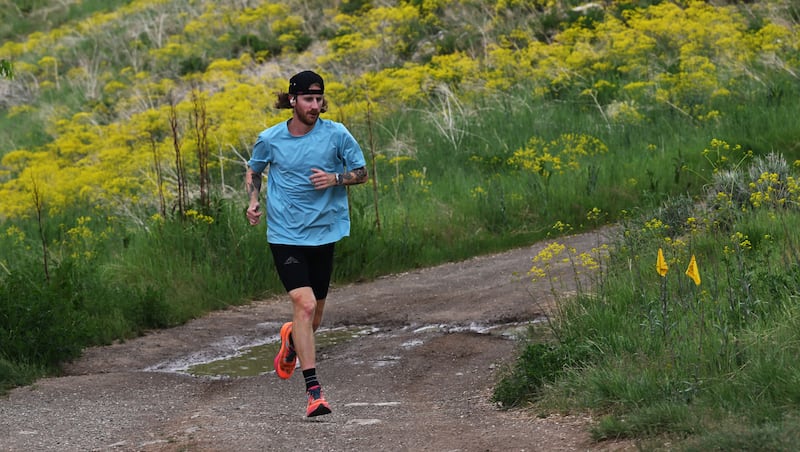In most communities along the Wasatch Front, if you venture past the developed areas and into the foothills, you will find a patchwork of trails winding up and across what used to be the shoreline of an ancient lake, all coming together to create the Bonneville Shoreline Trail.
The patches of trails scattered over hundreds of miles are each unique, some lined with lush trees and colorful wildflowers, some stretching over steep or rocky terrain, while others overlook vast valleys and narrow canyons.
Bikers, trail runners and hikers have enjoyed the trail for years, even as it has grown and changed over decades.
Those who use the trail, from professional trail runners to casual outdoor enthusiasts who run the trail after work, said they appreciate how accessible the trail is and how it provides something for everyone.
“I think accessibility, that‘s always been the name of the game for the Salt Lake City kind of trail scene around here,” said Grant Barnette.
The trail, which follows the shoreline of ancient Lake Bonneville, is far from complete, but has been growing over the last three decades as communities across the Wasatch Front have linked themselves together by building individual sections of the trail.
When the trail first began, Salt Lake City was the focus, but the vision has grown drastically since then. Today, the trail stretches over 170 miles along the historical eastern edge of Lake Bonneville, connecting dozens of cities across Utah.
A man takes a hike near the Bonneville Shoreline Trail on Monday, May 5, 2025. | Scott G Winterton, Deseret News
Carly Lansche, trails and planning program director for the Utah Division of Outdoor Recreation, said the vision is to have a contiguous trail for nonmotorized use stretch from Nephi in Juab County north to the Idaho border.
“The continuity of it through our most populated areas, I think, is just a powerful thought. I mean, we have I-15 and our road corridors extending through our communities that connect us all, and our trails do the same thing in just a little bit of a different way,” Lansche said
Proponents hope the trail will someday stretch to around 400 miles, connecting trails and communities across Utah.
“The state has been very interested in connections between cities,” said Charles Wheeler, a former mayor of Hyde Park, who has helped build sections of the trail in Cache Valley.
How the Bonneville Shoreline Trail began
The concept of the Bonneville Shoreline Trail started in 1989. It began as an effort to preserve a biking, jogging and walking pathway along a corridor between Emigration Canyon and Dry Canyon on the eastern edge of Salt Lake City.
Part of the pathway travels into This Is The Place Heritage Park in the mouth of Emigration Canyon, and when the park staff wanted to fence off the area, many recreationists protested. They didn’t want to be fenced out of the area or required to pay fees. Eventually, the groups found a solution and a fence line was created below the recreation corridor.
“Every time you see one of these things, there’s always some crisis that precipitates people getting involved and getting organized and that was the initial crisis that kind of led people to say, ‘oh, we need to do something to get this kind of permanently preserved,’” said Brandon Plewe, a professor of geography at Brigham Young University who teaches map design.
Around the same time that the compromise was worked out, Salt Lake City adopted the Bonneville Shoreline Trail as a formal trail system in the foothills east and north of the city. In 1991, the Bonneville Shoreline Trail Committee was formed in order to promote development of the trail and implement it in other places around Salt Lake County.
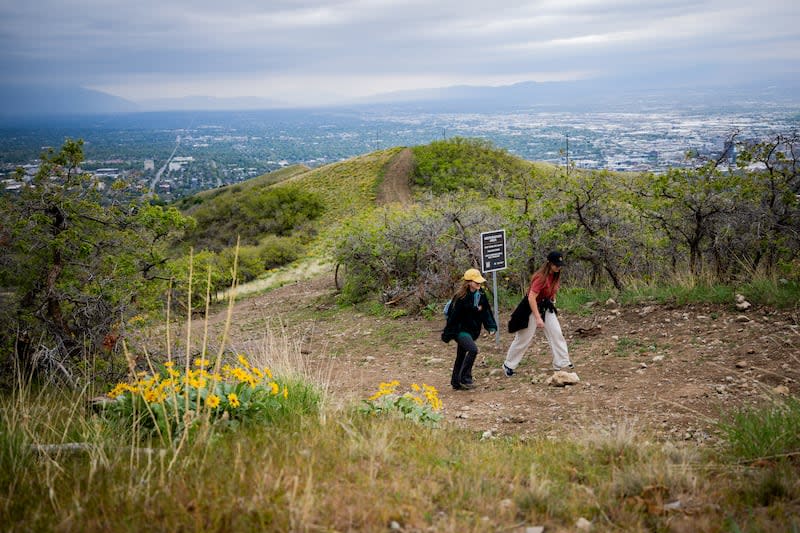
Lauren Johnson, from Salt Lake, left, and friend Brooklyn Eborn, from Kaysville, right, hike on the Bonneville Shoreline Trail in Salt Lake City on Monday, May 5, 2025. | Tess Crowley, Deseret News
Eventually, other places like Davis County and Utah County began to adopt the identity of the Bonneville Shoreline Trail for the foothill trails, plans and segments already in place in those areas.
In 1994, representatives from Utah, Salt Lake, Davis and Weber counties decided that there should be one continuous foothill shoreline trail along where the ancient Lake Bonneville used to be.
Since that time, many different communities and groups have acquired and built new sections of the trail, growing it to where it stands today at 170 miles long.
“The Bonneville Shoreline Trail is a perfect example of like a legacy, kind of multigenerational vision,” Lansche said.
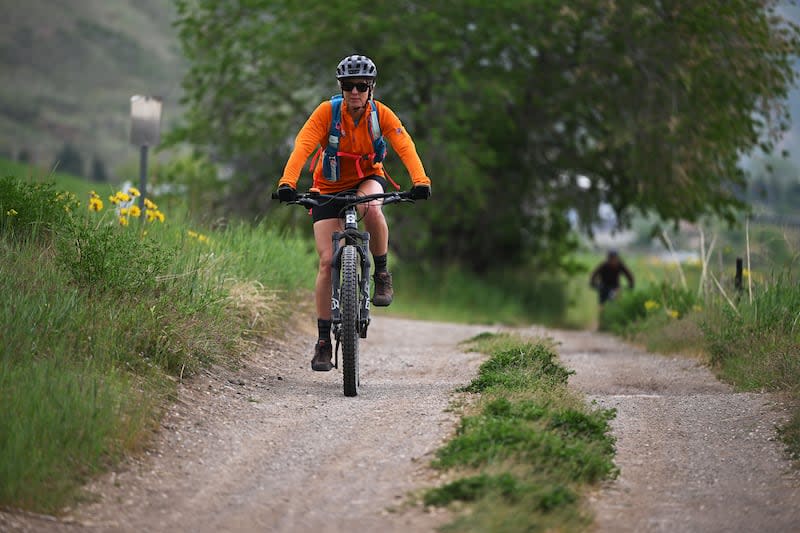
Jen Hollingsworth rides her bike along the Bonneville Shoreline Trail on Monday, May 5, 2025. | Scott G Winterton, Deseret News
The Bonneville Shoreline Trail is a patchwork across the Wasatch Front
Plewe first got interested in the Bonneville Shoreline Trail 20 years ago, when he was working on a street map of the Wasatch Front and wanted to include the trails in the area.
As he looked into the trail, Plewe had a hard time determining what parts were done and which ones weren’t, as different sources told him different things.
“There’s a lot of question about this. And in my research, I’m always interested in uncertainty and things that are kind of in a weird state. And so I just kind of got interested in this, my mission has been trying to just sort out what‘s done, what‘s not done,” he said.
The Bonneville Shoreline Trail Committee still exists, but it has fizzled out over the years, leaving the responsibility of constructing and maintaining the trail to individuals, cities and other groups.
“Really kind of the whole time, it‘s been a very kind of piecemeal thing, because nobody is really in charge of it,” Plewe said.
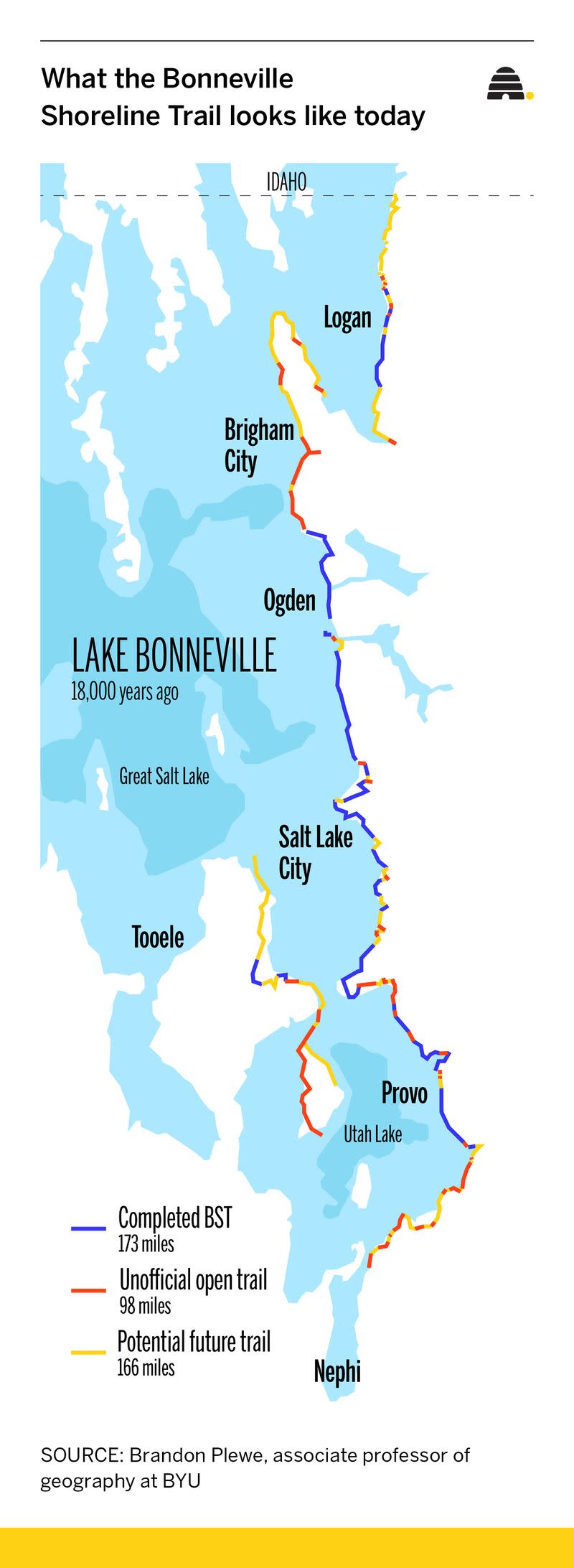
DN-Bonneville Shoreline Trail map
The responsibility for the upkeep of the trail has fallen to individuals like Wheeler, who helped get funding and acquire land for sections of the trail in Cache Valley. He has also worked to help build those trail sections.
While around 170 miles of the trail have been completed, it is not all connected. The current Bonneville Shoreline Trail is a mix of official sections that are well maintained, stretches that need work, old roads, unofficial trails and large gaps between sections.
Jen Hollingsworth, who works at the University of Utah Hospital, is on the Bonneville Shoreline Trail biking or running around three times a week, sometimes on her own and other times with friends or co-workers.
Hollingsworth said she thinks the goal of having the Bonneville Shoreline Trail stretch so far across the state of Utah is a great opportunity.
“The idea of being able to connect communities, counties and then even states together, I think, is fantastic, and I really hope one day we get there,” she said.
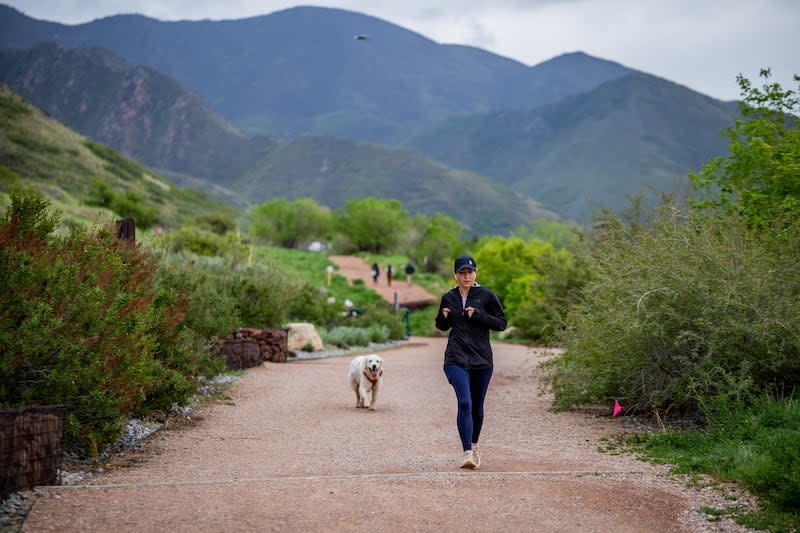
Annabelle Amick, from Salt Lake City, runs on the Bonneville Shoreline Trail in Salt Lake City on Monday, May 5, 2025. | Tess Crowley, Deseret News
What recent additions have been made to the trail?
So far, 170 miles of the trail have been completed since the idea started in 1990. Over the years the plans for how far the trail would reach have changed, but Plewe says currently there are plans for around 400 total miles.
There have been recent additions made to the trail; in 2023, an approximately 6-mile section was added in the Herriman area. There was also recently new land acquired for the trail in Pleasant Grove near the Battle Creek Trail.
In Cache Valley, specifically in Hyde Park, Wheeler recently helped a section of the trail be finished, after about three years to build. At the time, it was the longest section that had ever been built at once, at around 2 miles.
Cache County has received funding from the state to build more sections of the trail that will be completed in phases, going north and south from the Hyde Park section.
Over the years, Plewe has worked to map out the trail and discover which sections are finished and which aren’t. To help share what he has found out about the trail, he started a YouTube series in 2021 called “State of the BST.”
Throughout the 32 videos, he hikes along the entire length of the Bonneville Shoreline Trail and shares with viewers the current state of the trail and how each piece came to be.
“I hope we learn a lot about the trail, its past, present and future,” Plewe said in the series’ first video.
How the trail gets expanded
One of the biggest obstacles for adding pieces to the trail is property and land ownership.
“When you look at a parcel map, you can see that it‘s a patchwork of different shapes and all of that. And Utah, we’re a private property rights oriented state, and so it‘s all about whether or not the trail’s on public land or if it is on private land, have those landowners been willing and and wanted to allow that access?” Lansche said.
Because of this, land has to be acquired piece by piece, and if landowners don’t want to contribute, then there’s nothing that can be done about that. Lansche said she sees some benefits for landowners who allow recreational trail access on their private property.
“It takes a really long time to enact the vision,” Lansche said. “But I think when people get energized about it, it shakes loose a couple of those sections that were stuck.”
Other issues must be considered while building the trail, according to Wheeler. The trail needs to be located high enough so that it doesn’t look right into windows of homes or backyards, and also put in a place where it can have good views. Designing the trail so that it provides good exercise and is easily accessible are also considerations when building new sections.
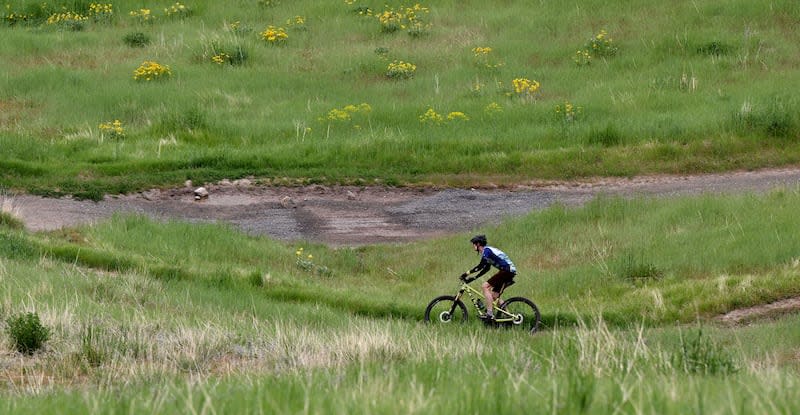
A biker rides on the Bonneville Shoreline Trail on Monday, May 5, 2025. | Scott G Winterton, Deseret News
In March, Utah Sens. Mike Lee and John Curtis introduced the Bonneville Shoreline Trail Feasibility Study Act. If passed, the bill would have the trail studied to evaluate whether it qualifies to become a National Scenic Trail or receive a different designation under the National Trails System.
Plewe said having a national designation would make it easier to get federal funding for the trail. It would also organize the effort, because each National Scenic Trail has an association tied to it that organizes maintenance and volunteers.
He added that the designation would not force private property owners to allow the trail to go through their property.
Following the shoreline of ancient Lake Bonneville
The vision for the Bonneville Shoreline Trail is to follow along the shoreline of the ancient lake that once filled so much of Utah.
“It‘s super cool how vast and expansive that once was,” said Hollingsworth when talking about Lake Bonneville.
Lake Bonneville was an ancient lake that filled the Great Basin during the late Pleistocene Period, covering much of the western United States. The Great Salt Lake is what is left behind of the ancient body of water.
But as the lake receded over thousands of years, it created a series of terraces, or benches. Many of Utah‘s cities, especially those on the Wasatch Front, are built on the lake’s lower benches. The Bonneville Shoreline Trail follows along the upper benches.
“Having it follow the Bonneville shoreline is a nice idea, but it‘s, it‘s not practical in a lot of areas,” Plewe said.
Plewe added that the ideal location of the trail sections are typically at the edge of developed land; the areas where development meets the wilderness are called the Wildland Urban Interface.
“The idea is to have a trail that‘s kind of at that lowest level, where it‘s kind of the easiest possible trail that is still in the natural area,” Plewe said. “We want it to be relatively level, relatively family friendly, for most of it. We’re not hiking up to the top of a mountain.”
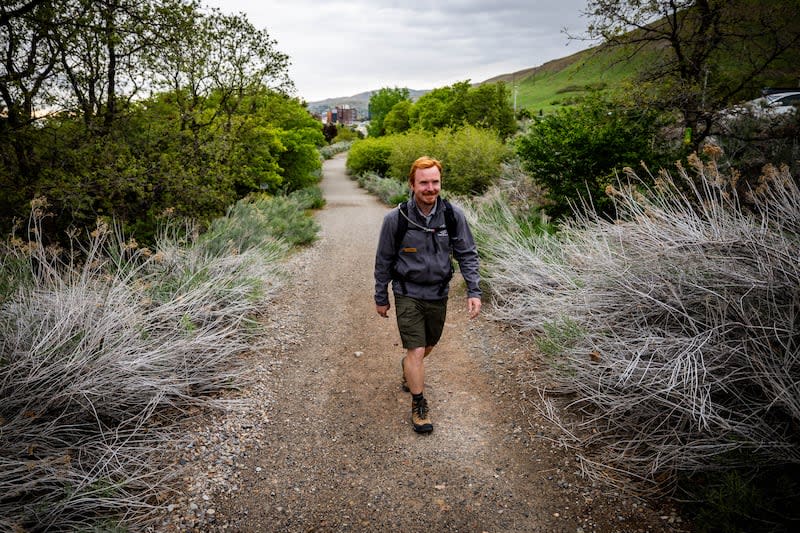
Kyle Webster, from Sandy, hikes on the Bonneville Shoreline Trail in Salt Lake City on Monday, May 5, 2025. | Tess Crowley, Deseret News
How the Bonneville Shoreline Trail benefits people in Utah
Wheeler has worked in construction and has helped design different roads, trails and parks over the years. After seeing the impact that trails can have, he was inspired to get involved in the Bonneville Shoreline Trail.
“I saw was how important it is for families, for individuals to get out and hike and be active, you know, for kids to play in parks and stuff,” Wheeler said. “I’ve seen what these parks and trails can add to the quality of life for the people that, you know, are involved around them.”
He added that as the state has seen the success of the Bonneville Shoreline Trail in the Salt Lake City area, it has begun to recognize the need for trails. This has led to a prioritization of the Bonneville Shoreline Trail and trails in other areas of Utah.
“You‘re seeing financial, economic impacts that come from having these trails, that people are actually traveling to some of these places as a destination for their activity,” Wheeler said.
Outdoor recreation is one of the top values for Utahns, Lansche said. Because the trail stretches through so many communities, with a number of different trailheads, it allows people to have a quick escape into nature, she added.
Barnette is a professional trail runner who runs on the Bonneville Shoreline Trail in Salt Lake City five or six times a week. He said he likes the trail because it is so easy to get to from the city and is well maintained.
“It just seems very easy, whether people are working full-time jobs or remote work, that you can quickly get out of your shift and get in a quick jog or really anything,” Barnette said. “Accessibility is the name of the game.”
Hollingsworth shared that she appreciates how the trail has something for everyone.
“You can be a family with young kids and get out and walk a good portion of the flat section, but then you can go off trail and, you know, get some pretty steep terrain, and there are even technical sections for biking. So I think it offers something for everybody in every fitness level,” she said.
Read the full article here

